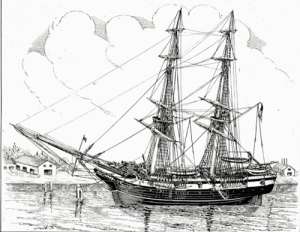
Lt. Thomas R. Gedney, a U.S. Navy officer commanding the U.S. Coast Survey Brig Washington on August 20, 1839, was surveying the area between New York’s Montauk Point and Gardiner’s Island. He “discovered a strange and suspicious looking vessel off Culloden Point, near said Montauk Point,” according to his statement to Connecticut District Court Judge Andrew T. Judson. Gedney and his officers took possession of the vessel. The ship captured by the Washington proved to be the Spanish schooner called L’Amistad – the ship carrying Africans who revolted against their captors and tried to sail back to Africa… Thus began a little known piece of U.S. Coast Survey history. (It is so little known, in fact, that the 1997 movie Amistad did not mention Coast Survey.)
The National Museum of African American History and Culture is presenting a new exhibit of six murals at the Smithsonian’s National Museum of American History. Rising Up: Hale Woodruff’s Murals at Talladega College, portrays the heroic resistance to slavery. Three of the six historic murals on exhibition refer to the slave ship Amistad.
Gedney’s capture of the Amistad was very early in Coast Survey’s history, when naval officers were assigned to command Coast Survey vessels. Gedney was one of the two first senior naval officers attached to the Coast Survey. (The other was George S. Blake.) In 1834, Gedney commanded the Coast Survey’s first hydrographic vessel, the Jersey, and in 1835 discovered the Gedney Channel into New York Harbor. Gedney is also known for tackling the would-be assassin of President Andrew Jackson on January 31, 1835, after the gunman’s pistol(s) had misfired ‒ twice. He reportedly protected the gunman, Richard Lawrence, from the wrath of the crowd so Lawrence could be brought to justice. Gedney joined the Navy in 1815, and died in 1857.
There were two trials on the Amistad: one criminal, for the mutiny; the other was a civil trial, where Gedney et.al. libeled (claimed) as “salvage” the cargo, provisions, cash, and “fifty-four slaves, to wit, fifty-one male slaves, and three young female slaves, who were worth twenty-five thousand dollars.” (See the copies of original documents at the National Archives.)
There were several competing claims for the Africans, involving Queen Isabella of Spain and the two men who said they owned the slaves. If you’ve seen the movie, you know that the case pivoted on the status of the men and women captured on the Amistad. The District Court ruled that the Africans were free individuals; kidnapped and transported illegally, they had never been slaves. Therefore, the court allowed salvage to Lieutenant Gedney and others, on the vessel and cargo, of one-third of the value thereof, “but not on the negroes…”

The court ordered President Martin Van Buren to have them transported back to Africa. After going through the appeal process, President Van Buren ordered government lawyers to appeal the case to the Supreme Court. The Supreme Court heard the case, with former president John Quincy Adams arguing against the government and on behalf of the Africans. On March 9, 1841, the Supreme Court ruled in favor of the Africans. They also provided a note on Gedney:
“As to the claim of Lieutenant Gedney for the salvage service, it is understood that the United States do not now desire to interpose any obstacle to the allowance of it, if it is deemed reasonable by the Court. It was a highly meritorious and useful service to the proprietors of the ship and cargo; and such as, by the general principles of maritime law, is always deemed a just foundation for salvage. The rate allowed by the Court, does not seem to us to have been beyond the exercise of a sound discretion, under the very peculiar and embarrassing circumstances of the case.”
In other words, Gedney got his share of the cargo, but not the “slaves” he had also claimed as prizes.
(Read the full Supreme Court decision, written by Justice Joseph Story.)
The Amistad murals will be on view at the National Museum of Natural History until March 2015.

News and Updates
Reblogged this on Boating Safety Tips, Tricks & Thoughts from Captnmike and commented:
A bit of hidden history from the NOAA Archives